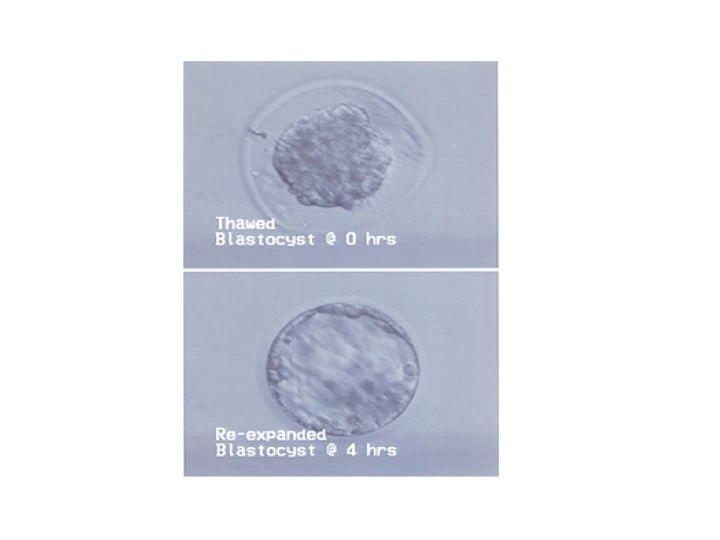
The key hormones that one needs to be familiar with are follicle stimulating hormone (FSH) and luteinizing hormone (LH). In patients with regular menses, the brain (pituitary gland to be more precise) will usually release just enough FSH and LH for one of the ovaries to produce a single follicle. This works fine in couples trying to conceive naturally. However, with a single egg, the pregnancy rates with IVF are low. We therefore use fertility injections containing higher doses of the same hormones (FSH and LH), to induce production of multiple follicles by the ovaries. This process is often referred to as “controlled ovarian hyperstimulation” or COH.
COH usually starts on day-3 of the cycle and it generally takes 9 – 11 days of stimulation for the follicles to reach a size where the eggs inside will be mature. On that day we will have the patient take her trigger shot of human chorionic gonadotropin (hCG). This is the final maturation step for the eggs and egg retrieval is scheduled 36 hours later.
During COH, we will monitor patients with serial blood tests and ultrasounds. This enables us to make sure that the patient is getting too much or too little of the medications and pinpoint the day when the patient is ready for her hCG trigger shot.
When patients are undergoing COH, it is important that the eggs are not released prematurely. This is important as if the patient ovulates, we will not have any eggs to retrieve! To prevent premature ovulation, we will add a GnRH analog to the stimulation protocol. There are two types of GnRH analogs that are commonly used – GnRH agonists (e.g. leuprolide acetate or Lupron) or GnRH antagonists (e.g. Ganirelix or Cetrorelix). The mechanism of action of the two types of medications is different (will be covered in a future blog). Lupron is generally started in the second half of the cycles prior to stimulation. Ganirelix (or Cetrorelix) is generally started on day-5 of COH or when the lead follicle(s) measure 13 mm in diameter.
At InVia, we will use Lupron for normal responders. For low and high responders we will often use Ganirelix (or Cetrotide). This is based on outcome based analysis of our previous experience.
There are several gonadotropin preparations currently marketed in the US. These include recombinant FSH (Follistim, Gonal-F), highly purified urinary FSH (Bravelle), and hMG (a combination of FSH and LH activity; Menopur, Repronex). These have all been shown to effective for COH.
There is an ongoing debate as to whether one should use FSH only stimulation (pure FSH) or a combination protocol i.e. FSH + LH. A recent survey confirmed that in the US, the vast majority of programs are using combination protocols. At InVia, we will use a combination protocol for the vast majority of our cycles. Especially in cycles where birth control pills are used to program cycle starts, we feel it is necessary for adding LH to the stimulation.
This still remains an art and it is likely that a panel of “experts” will each come up with a different starting dose for a particular patient. The goal should be to get the maximum number of mature oocytes and at the same time avoiding ovarian hyperstimulation syndrome (OHSS). The various factors that effect ovarian response have been discussed in a previous blog. AMH and AFC are currently considered to be the two best markers for predicting ovarian response. Using age alone for deciding the starting dose is not a good strategy. A comparison of the characteristics of the most widely used markers of ovarian reserve is presented in the table below.

In Europe, they tend to use a lower starting dose for COH. They will generally use 150-units/ day for high responders, 225-units/ day for normal responders and 300-units/ day of gonadotropins for low responders. There have been some publications comparing a starting dose of 150 iu/day with 200 – 300 IU/day with no increase in the number of eggs retrieved. In the U.S. (where the pregnancy rates are much higher than Europe) we tend to be a bit more aggressive with our stimulations. At InVia we will use 150 units for high responders, 225 – 300 units for normal responders and 450 – 600 units for low responders.
The details of the stimulation protocols used at InVia will be discussed in the next blog.

Dr. Karande is Board Certified in the specialty of Obstetrics and Gynecology as well as the subspecialty of Reproductive Endocrinology and Infertility. He is a Fellow of the American College of Obstetricians and Gynecologists and Member of the American Society for Reproductive Medicine.
Subscribe to our weekly blog digest

Entire Website © 2003 - 2020
Karande and Associates d/b/a InVia
Fertility Specialists

Comments